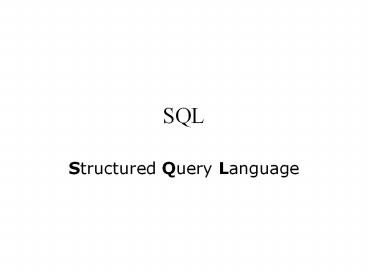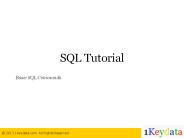SQL - PowerPoint PPT Presentation
1 / 34
Title:
SQL
Description:
SQL Structured Query Language SQL Database Tables SQL Queries SQL Data Manipulation Language (DML) SQL Data Definition Language (DDL) SQL The SELECT Statement Select ... – PowerPoint PPT presentation
Number of Views:94
Avg rating:3.0/5.0
Title: SQL
1
SQL
- Structured Query Language
2
SQL is a Standard - BUT....
3
SQL Database Tables
4
SQL Queries
5
SQL Data Manipulation Language (DML)
6
SQL Data Definition Language (DDL)
7
SQL The SELECT Statement
8
To select the columns named "LastName" and
"FirstName", use a SELECT statement like
this SELECT LastName, FirstName FROM Persons
9
Select All Columns
To select all columns from the "Persons" table,
use a symbol instead of column names, like
this SELECT FROM Persons
10
The Result Set
The result from a SQL query is stored in a
result-set. Most database software systems allow
navigation of the result set with programming
functions, like Move-To-First-Record,
Get-Record-Content, Move-To-Next-Record,
etc. Programming functions like these are not a
part of this tutorial. To learn about accessing
data with function calls, please visit our ADO
tutorial.
11
Semicolon after SQL Statements?
Semicolon is the standard way to separate each
SQL statement in database systems that allow more
than one SQL statement to be executed in the same
call to the server. Some SQL tutorials end each
SQL statement with a semicolon. Is this
necessary? We are using MS Access and SQL Server
2000 and we do not have to put a semicolon after
each SQL statement, but some database programs
force you to use it.
12
The SELECT DISTINCT Statement
The DISTINCT keyword is used to return only
distinct (different) values. The SELECT statement
returns information from table columns. But what
if we only want to select distinct elements? With
SQL, all we need to do is to add a DISTINCT
keyword to the SELECT statement
Syntax SELECT DISTINCT column_name(s) FROM
table_name
13
Using the DISTINCT keyword
To select ALL values from the column named
"Company" we use a SELECT statement like
this SELECT Company FROM Orders
14
Note that "W3Schools" is listed twice in the
result-set. To select only DIFFERENT values from
the column named "Company" we use a SELECT
DISTINCT statement like this SELECT DISTINCT
Company FROM Orders
15
Select All Columns
The WHERE clause is used to specify a selection
criterion. The WHERE Clause To conditionally
select data from a table, a WHERE clause can be
added to the SELECT statement.
Syntax SELECT column FROM table WHERE column
operator value
16
With the WHERE clause, the following operators
can be used
Note In some versions of SQL the ltgt operator may
be written as !
17
Using the WHERE Clause
To select only the persons living in the city
"Sandnes", we add a WHERE clause to the SELECT
statement SELECT FROM Persons WHERE
City'Sandnes'
18
Using Quotes
Note that we have used single quotes around the
conditional values in the examples. SQL uses
single quotes around text values (most database
systems will also accept double quotes). Numeric
values should not be enclosed in quotes. For text
values
This is correct SELECT FROM Persons WHERE
FirstName'Tove' This is wrong SELECT FROM
Persons WHERE FirstNameTove
19
The LIKE Condition
The LIKE condition is used to specify a search
for a pattern in a column.
Syntax SELECT column FROM table WHERE column LIKE
pattern
A "" sign can be used to define wildcards
(missing letters in the pattern) both before and
after the pattern.
20
Using LIKE
The following SQL statement will return persons
with first names that start with an 'O' SELECT
FROM Persons WHERE FirstName LIKE 'O' The
following SQL statement will return persons with
first names that end with an 'a' SELECT FROM
Persons WHERE FirstName LIKE 'a'
21
Using LIKE 2
The following SQL statement will return persons
with first names that contain the pattern
'la' SELECT FROM Persons WHERE FirstName
LIKE 'la'
22
SQL The INSERT INTO Statement
23
The INSERT INTO Statement
The INSERT INTO statement is used to insert new
rows into a table.
Syntax INSERT INTO table_name VALUES (value1,
value2,....)
You can also specify the columns for which you
want to insert data INSERT INTO table_name
(column1, column2,...) VALUES (value1,
value2,....)
24
Insert a New Row
And this SQL statement INSERT INTO Persons
VALUES ('Hetland', 'Camilla', 'Hagabakka 24',
'Sandnes')
25
Insert Data in Specified Columns
And This SQL statement INSERT INTO Persons
(LastName, Address) VALUES ('Rasmussen', 'Storgt
67')
26
SQL The UPDATE Statement
27
The Update Statement
The UPDATE statement is used to modify the data
in a table. Syntax UPDATE table_name SET
column_name new_value WHERE column_name
some_value
28
Update one Column in a Row
We want to add a first name to the person with a
last name of "Rasmussen" UPDATE Person SET
FirstName 'Nina' WHERE LastName 'Rasmussen'
29
Update several Columns in a Row
We want to change the address and add the name of
the city UPDATE Person SET Address 'Stien
12', City 'Stavanger' WHERE LastName
'Rasmussen'
30
SQL The Delete Statement
31
The Delete Statement
The DELETE statement is used to delete rows in a
table. Syntax DELETE FROM table_name WHERE
column_name some_value
32
(No Transcript)
33
Delete a Row
"Nina Rasmussen" is going to be deleted DELETE
FROM Person WHERE LastName 'Rasmussen'
34
Delete All Rows
It is possible to delete all rows in a table
without deleting the table. This means that the
table structure, attributes, and indexes will be
intact DELETE FROM table_name Or DELETE
FROM table_name































